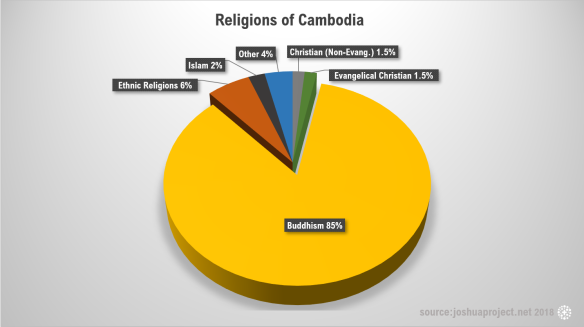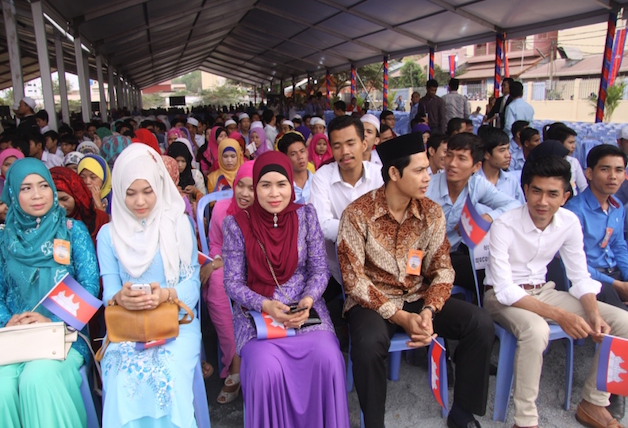Cambodian religion and belief
The official religion is Buddhism with about 85% of Cambodia's population is Buddhism. Besides, Islam, Christianity, and tribal animism make up the rest. All religions and beliefs combine in harmony to create a rich spiritual life and dominate Cambodian cultural life.

Buddhism
Buddhism has existed in Cambodia since at least the 5th century AD, with some origins dating back to the early 3rd century BC. Theravada Buddhism was the religion of Cambodia from the 13th century AD (except for the Khmer Rouge), and is now estimated to be a religion of 85% of the population (2018)
During the first 1,000 years of Khmer history, Cambodia was governed by many Hindu kings, occasionally a Buddhist monarch, such as Jayavarman I king of Funan, and Suryavarman I. A variety of Buddhist traditions peacefully coexisted throughout the lands of Cambodia, tolerated by the Hindu kings and neighboring Mon-Theravada kingdoms.

Hinduism
Cambodia was first influenced by Hinduism in the early Funan Kingdom. Hinduism was one of the official religions of the Khmer Empire. One of only two temples dedicated to Brahma in the world is located in Cambodia. Cambodia's Angkor Wat is the largest Hindu temple in the world.
Islam

Photo: khmer440
As reported by Po Dharma, there were 150,000 to 200,000 Muslims in Cambodia by the end of 1975 while the research papers of Ben Kiernan amounted to 250,000. However, the persecution under the Khmer Rouge significantly decreased in numbers in the late 1980s. All Cham Muslims are Sunni Muslims of the Shafii school.
The Cambodian has about 100 mosques mosque within the country in 1962. In the last 19th century, Cambodian Muslims established a united community under four religions: mupti, tuk kalih, raja kalik, and tvan pake. The People's Council in Cham village included a hakem and some katip, bilal, and labi. Four senior officials and hakem were free from personal taxes and were invited to attend important national ceremonies at the court.
After the independence of the country, the Muslim community was controlled by a five-member council representing the community in its legal functions and liaison with other Muslim communities. Each Muslim community has a hakem for the community and mosque, an imam to lead prayers, and a fellow countryman who calls on the faithful to pray daily.
The Chrouy Changvar peninsula nearby Phnom Penh is the spiritual centre of the Cham people, and several high Muslim officials stay here. According to data from the late 1950s, about 7% of Cham people have completed the pilgrimage and can wear fez or scarf as a sign of their fulfillment.
Christianity
The first known Christian evangelization in Cambodia was carried out by Gaspar da Cruz, a Portuguese member of the Sisters of Brethren who carried out the Christian evangelization in Campuchia for the first time during the years 1555-1556.
Despite the French domination, Christianity had little impact on Cambodia. In 1972, the number of was Christians about 20,000 mainly Roman Catholics. Before the Vietnamese were repatriated in 1970 and 1971, there were probably about 62,000 Christians living in Cambodia.
As the report of the Vatican, participants of the Roman Catholic Church in Cambodia by 1953 amounted to 120,000, ranking the second biggest religion at that time. A lot of the Catholics who stayed in Cambodia in 1972 were from Europe – mostly from France.
Currently, there are 20,000 Catholics, representing 0.15% of the entire population of Cambodia. Other Christian branches include the Baptist, the Christian Union, and the missionaries, the Methodist Movement, Jehovah's Witnesses, the Pentecostal Movement, and The Church of Jesus Christ of Latter-day Saints.
Tribal religions
The highland tribal groups, most of them have a local religious system, include about 150,000 people. The Khmer Loeu are loosely depicted as animists, however, almost all local ethnic groups have local deities of themselves.
Generally, they think unseen spirits exist in this real-life (often referred to as Ocean), some benevolent, others wicked. They associate spirit with rice, earth, water, fire, stone, and path, ... The wizards, sorcerers, or experts in each village connect with the spirits and designate ways to pacify them. During times of crisis or change, animal sacrifices can be made to appease the fury of souls (scapegoats). Illnesses are often attributed to demons or witches. Some tribes have special medicine men or magicians who treat illnesses. In addition to spiritual beliefs, people also believe in prohibitions about many subjects or practices.
Judaism
The Jewish community in Cambodia is trivial with over 100 people in a Chabad house that was built in Phnom Penh in 2009.
Maybe you like our Cambodia tours: Highlights of Cambodia Tour | Cambodia Vietnam Tour Package 2024 / 2025 | Must-sees of Cambodia Laos Vietnam Tour - 19 days itinerary

